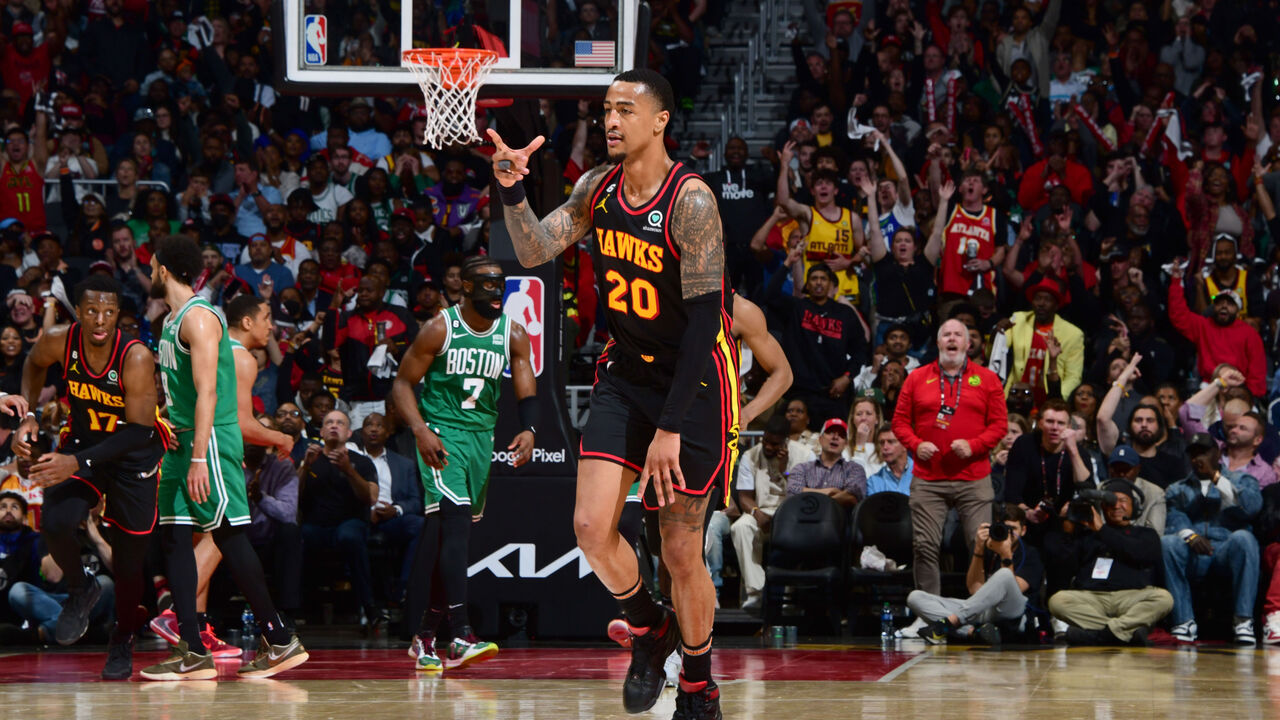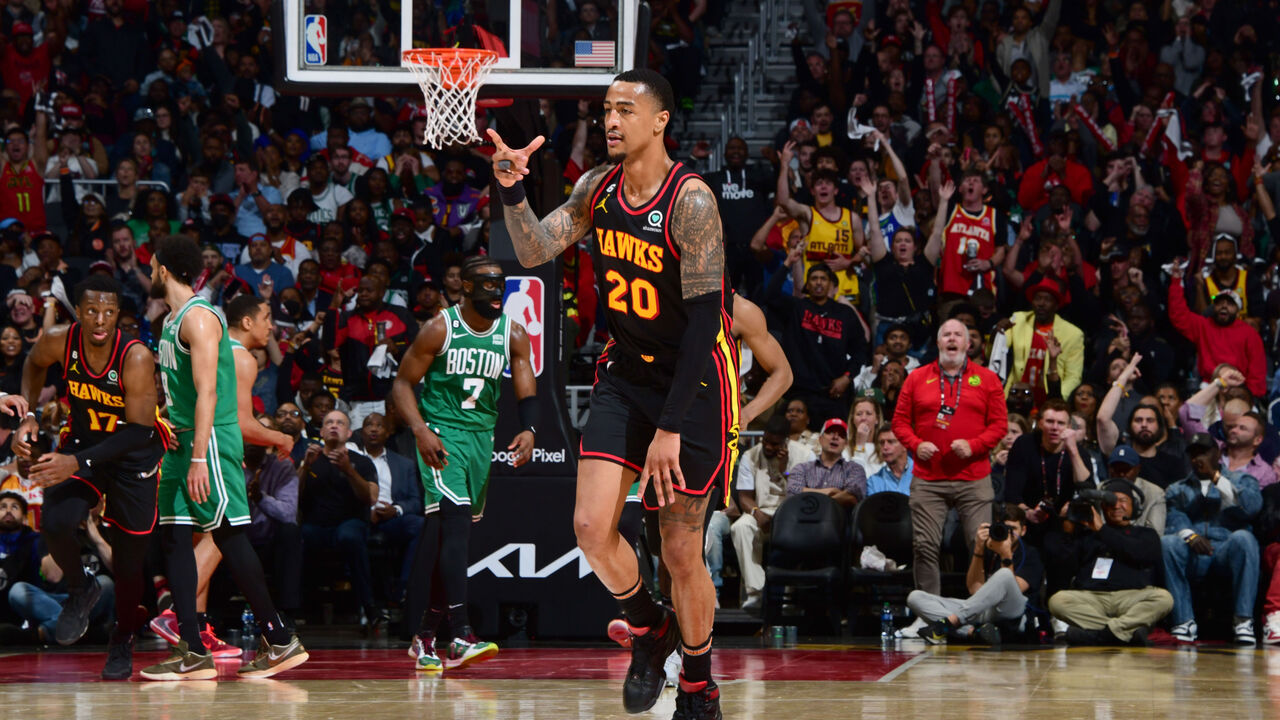The John Collins trade shows what today's NBA does and doesn't value
In August 2021, a month after he helped lead them to within two wins of the Finals, the Atlanta Hawks re-signed John Collins to a five-year, $125-million contract. He became trade-eligible about five months later and was basically on the block from right then until the Utah Jazz acquired him Monday afternoon.
After being bandied about in rumors and fake trades for the better part of two years, Collins netted a shockingly paltry return. The Hawks could only pry the husk of Rudy Gay and a distant second-round pick from Danny Ainge’s icy grasp in exchange for a 25-year-old who owns a 63% career true shooting mark and was, at worst, the third-best player on a conference finalist two years ago. It’s not like Atlanta is pivoting away from win-now mode, either. So why did a good young player on a team aiming to contend just get shipped out for nothing?
First, it’s clear that Atlanta’s motivation in making this move was simply to get out from under the three years and $78 million remaining on Collins’ contract. It’s no accident that the first line of Adrian Wojnarowski’s team-sourced ESPN report was about the Hawks’ newfound financial flexibility. If they’d been willing to take back more than just Gay’s $6.5-million expiring deal, the Hawks almost certainly would’ve been able to acquire a better player and/or better draft assets in the exchange.
But Atlanta is coming off two straight first-round exits, has new deals on the horizon for a handful of key rotation players (Dejounte Murray, Bogdan Bogdanovic, Onyeka Okongwu, Saddiq Bey), and must deal with new upper-limit spending penalties coming in the next collective bargaining agreement. The team was focused on shedding as much payroll as possible. The biggest reason the Jazz were able to get Collins for so little is that they could just plunk him into their ocean of cap space without having to send back matching salary.
It’s hard to say whether the new CBA was actually a major factor, regardless of Wojnarowski’s reporting to that effect. The Hawks, after all, have never even paid the luxury tax under Tony Ressler’s ownership group, let alone exceeded that threshold to such an extent that they’d be in danger of breaching the dreaded second apron. The specter of those impending changes feels more like the pretense for an unpopular move. But we can wait to see what the Hawks do with this vaunted financial flexibility – including the $25-million trade exception they just created – before rendering judgment.

The other, more interesting angle to explore here is what this trade says about Collins and players of his ilk. Collins is an undeniably talented player with great physical tools, but being straight-up salary-dumped reinforces the fact that he represents one of the least desirable archetypes in the league right now. He’s a “traditional power forward” in the most damning sense of the term.
When I wrote about the state of that position a few years ago, the NBA was in the process of breaking into two distinct factions regarding frontcourt construction. Most of the league was treating the power forward as another wing position, filling it with players who could bomb threes, create a bit off the bounce, and guard on the perimeter. Other teams were starting to zag back in the other direction, deploying two-big lineups with power forwards who could protect the rim and rebound like centers. The odd team lucked into a 4 who could meld those two categories into one.
Collins, on the other hand, doesn’t really embody either role. That’s why, despite possessing a lot of desirable attributes and skills – vertical athleticism, strength, touch around the basket, post-scoring chops – he doesn’t fit neatly onto many teams. He’s a power forward who’s only really equipped to defend other power forwards. He’s not a wing-like playmaking 4, or a jumbo rim-protecting 4. He once at least seemed like a viable stretch 4 (he shot 40% from deep on 3.4 attempts per game between the 2019-20 and 20-21 seasons), but that 3-point shooting really dried up over the last two years.
Collins is a nasty interior scorer and pick-and-roll finisher, but he never had the size or defensive instincts to capably play center, which has made it difficult for him to access the best parts of his offensive game. His defensive limitations are why the Hawks saw fit to trade for and extend Clint Capela, a lob-catching dive man who quickly became Trae Young’s primary pick-and-roll partner. Collins was consequently required to spot up and occupy the dunker spot more often, and though he still found opportunities to cut, duck in for post seals, and scavenge for putbacks, he became increasingly marginalized within the Hawks’ offense from the moment Capela arrived in 2020.
That process accelerated after last summer’s big trade for Murray, another high-usage creator who made the team’s spacing even more tenuous. Collins was less welcome than ever in the middle of the floor. Even as his 3-point percentage cratered to a career-worst 29% last season, he took a career-high 34% of his shots from beyond the arc.
| Season | Usage % | Roll-man possessions | Paint touches | At-rim FGA |
|---|---|---|---|---|
| 2019-20 | 22.7 | 5.1 | 9.4 | 7.8 |
| 2020-21 | 22.2 | 2.5 | 6.1 | 4.7 |
| 2021-22 | 20.5 | 2.7 | 5.6 | 4.6 |
| 2022-23 | 17.1 | 1.5 | 3.4 | 3.5 |
(Source: NBA Advanced Stats)
Because of all the issues created by his aforementioned positional inflexibility, other teams weren’t exactly banging down the door trying to rescue him from a difficult situation. The truth is there are very few potential frontcourt partners around the league capable of insulating him on defense and facilitating a rim-running role for him on offense. The Indiana Pacers would’ve been an ideal landing spot, but outside of that, he was about as good a fit in Atlanta as he’d be anywhere else, especially when you consider the way Young’s passing wizardry helped unlock his finishing ability.
The guess here is that rather than seeking to replace Collins with a stylistically comparable power forward, the Hawks will just look to have big wing types like De’Andre Hunter, Bey, and Jalen Johnson sop up most or all of the available minutes at the 4.
The Jazz, meanwhile, get to take a low-risk bet on a player who can help them lean further into a burgeoning trend running in the opposite direction: tall ball. In Utah, the 6-foot-9 Collins will join a frontcourt that already has three 7-footers in rookie center sensation Walker Kessler, All-Star forward and reigning Most Improved Player Lauri Markkanen, and stretch big Kelly Olynyk, not to mention another 6-foot-9 forward in Taylor Hendricks, whom the team just drafted ninth overall.
Escaping Atlanta only to land in an even more logjammed frontcourt might not seem like the best outcome for Collins individually, but Olynyk’s ability to space the floor and Markkanen’s capacity to function as an oversized wing who can score in every which way should allow for some workable permutations. The Jazz played Kessler, Olynyk, and Markkanen together for 454 minutes last season, outscoring opponents by 5.3 points per 100 possessions.
The Jazz will also have good reason to cater to Collins’ strengths and feature him as much as possible since they have a vested interest in rebuilding his trade value. Simply getting him back to being a league-average 3-point shooter would go a long way toward achieving that end.
Knowing Ainge, Collins could very well find himself right back on the trade block by December. The extent to which he’s able to adapt in Utah will determine whether there’s a bigger market for his services next time around.


